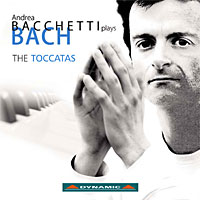

Feature article by
Phillip Scott
 BACH Toccatas,
BWV 910-916 • Andrea Bacchetti (pn) • DYNAMIC CDS 658 (79:43)
BACH Toccatas,
BWV 910-916 • Andrea Bacchetti (pn) • DYNAMIC CDS 658 (79:43)
 I enjoyed Andrea Bacchetti's previous Bach release (see my review in Fanfare 33:3) and the
same strengths are in evidence here: a sensitivity to dynamics (without going to stylistically
inappropriate extremes), a clear and precise technique, integrated ornamentation that does not
fracture the melodic line, and also the distinctive sound of Bacchetti's Fazioli piano, which
serves this music well by combining something of the attack of the harpsichord with the touch
sensitivity of the pianoforte.
I enjoyed Andrea Bacchetti's previous Bach release (see my review in Fanfare 33:3) and the
same strengths are in evidence here: a sensitivity to dynamics (without going to stylistically
inappropriate extremes), a clear and precise technique, integrated ornamentation that does not
fracture the melodic line, and also the distinctive sound of Bacchetti's Fazioli piano, which
serves this music well by combining something of the attack of the harpsichord with the touch
sensitivity of the pianoforte.The seven keyboard toccatas are early works, written in Bach's 20s following his well-documented trek to Lübeck in 1705 to hear Buxtehude play. These are virtuoso pieces with an exuberant improvisatory quality, often dazzling us with scales and arpeggios. Even when solemnity is required (as in the D-Minor Toccata), there is still something presentational about the music, an aspect that Bach eschewed by the time of his late keyboard works. Bacchetti understands this, as contemporary pianists must, in a historically informed way. He does not let the virtuosity or free-flowing passages become an excuse for idiosyncratic personal touches, but retains a level of poise and control throughout. There are many examples of this: the fugal allegro movement of the C-Minor Toccata, where Bacchetti keeps the tempo absolutely steady as the counterpoint becomes increasingly dense; or the delightfully brisk fugue concluding the G-Major Toccata, a piece that could easily have come from one of the Well-Tempered Clavier sets.
The best known of these toccatas, that in D Major, exists in two versions, the second of which is the more elaborate. Bacchetti plays this version, but chooses the earlier of the two extant versions of the D-Minor Toccata, BWV 913. He is especially sensitive in the plangent first and second movements of the D Minor, making the thematic lines positively sing, and again in the allegro of the G Minor. What lovely music this is.
There is less recorded competition from pianists in the toccatas than in Bach's other keyboard works. Glenn Gould and Angela Hewitt have each recorded the whole set, but unfortunately I don't have their recordings at hand for comparison. In Gould's case it probably is not necessary: The further removed we are from Gould in time, the more he seems like a one-off, functioning outside of the mainstream (no matter how much he may have influenced re-creative thinking). Hewitt's 2002 recording was described by Michael Carter in Fanfare 26:3 as "revelatory"; clearly, it is very good.
I can only reiterate my opinion that Bacchetti achieves the best of all possible worlds in his approach. His distinctive piano is set back in a fairly resonant acoustic, but clarity does not suffer. This disc is strongly recommended. Phillip Scott
This article originally appeared in Issue 34:1 (Sept/Oct 2010) of Fanfare Magazine
read more: Jens F. Laurson (Interview)